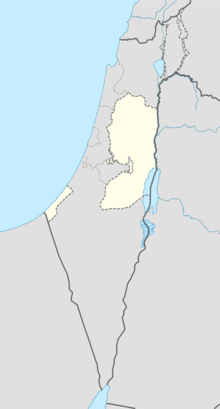Naaran
 Remnants of Naaran synagogue mosaic | |
| Location | West Bank |
|---|---|
| Coordinates | 31°53′02″N 35°26′41″E / 31.883826°N 35.444813°E |
Naaran (also Na'aran) (Template:Lang-he-n) is an ancient Jewish village dating to the 5th and 6th century CE, located in the West Bank. Remains of the village have been excavated north of Jericho, in Ephraim, between Bethel and Jericho. The mosaic floor of a synagogue was discovered at the site featuring a large zodiac design. Naaran is mentioned in Joshua 16:7 and 1 Chronicles 7:28 as a town in the eastern part of Ephraim.[1] Eusebius, in his Onomasticon, makes mention of the site, saying that in his day it was "a village inhabited by Jews, five [Roman] miles from Jericho."[2] The site is also named in the writings of Josephus (Antiquities 17.13.1), under its name (Template:Lang-gr),[3] and in the Midrash Rabba (Leviticus Rabba 23:5). Aramaic inscriptions and mosaics from the synagogue are displayed at an archaeology museum established by the Israeli archaeologist Yitzhak Magen at the Good Samaritan Inn.[4]
In May 2012, the ancient synagogue was vandalized with graffiti that included swastikas and Palestinian flags.[5] Israel's Public Diplomacy Minister Yuli-Yoel Edelstein condemned the act and noted that, "The incident reaffirms the belief that Jewish holy sites must be under Israel's sovereignty."[5]

An Israeli settlement, kibbutz Niran, located several kilometers to the north, takes its name from Naaran.
See also
- Shalom Al Yisrael Synagogue
- Mevo'ot Yericho
- Yitav
- Oldest synagogues in the world
- Archaeology of Israel
References
- ^ Easton's Bible Dictionary
- ^ Eusebius, Onomasticon - The Place Names of Divine Scripture, (ed.) R. Steven Notley & Ze'ev Safrai, Brill: Leiden 2005, p. 130 (§732) ISBN 0-391-04217-3.
- ^ Albright, W.F. (1924). "Excavations and Results at Tell el-Fûl (Gibeah of Saul) (1922-1923)". The Annual of the American Schools of Oriental Research. 4. American Schools of Oriental Research: 153 (note 3). JSTOR 3768487.
- ^ Inn of the Good Samaritan Becomes a Museum
- ^ a b Itamar Fleishman (25 May 2012). "Swastikas sprayed on ancient synagogue near Jericho". Ynetnews.

